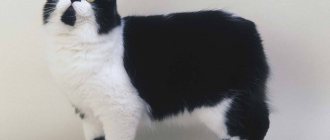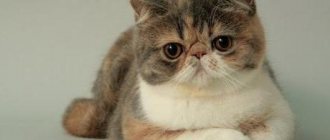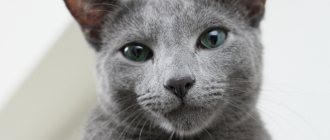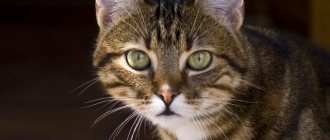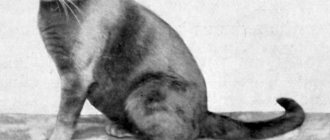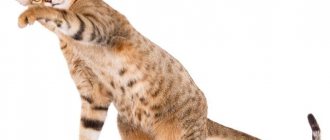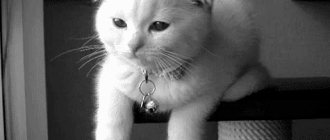The color white has long evoked conflicting associations among different peoples. It is a symbol of purity, innocence, sorrow, and new beginnings. There is still debate about the nature of white cats. Some consider them the most obedient and calm individuals of all felines. Someone, on the contrary, warns against purchasing cats with this color due to the difficulties of their character. What does a person who decides to open their doors to a snow-white four-legged pet have to face? Let's find out.
White cat
Origin of snow color
It is simply impossible not to notice the snow-white cat among his brothers. This angelic creature attracts the attention and wins the hearts of even those people who do not consider themselves cat lovers. There is a certain magic in snow-white cats. Perhaps the reason lies in the genes of the pet.
A kitten most often inherits its snow-white color from its parents.
Pigmentation of an animal's fur occurs long before it is born. Even at the stage of embryo formation, pigment cells are formed in its nerve fibers. They are not yet able to color their fur. These cells acquire their main function already on the way to the hair follicles. At this same stage, pigment cells are modified under the influence of genes inherited from the kitten’s parents. It is this “inheritance” that determines the color, location of spots on the body and their shape.
It is possible to determine which gene was responsible for the cat’s color only through further crossing.
However, it also happens that during the transformation some cells lose the ability to produce pigment. This is how kittens with white points are born - in “socks”, with a “shirt front” or with a snow-colored belly.
It also happens that absolutely all the cells decide to “rest” and not dye the fur in any of the colors. One insidious gene sends them on vacation - W. Having appeared in the genotype, W suppresses all other colors, coming to the fore. This is how snow-white kittens are born. For example, the genotype BBOoSsddWw will belong to a kitten with colorless fur, despite the presence of color genes.
It is quite easy to identify an albino kitten: its eyes will not have a blue tint.
If we are not talking about albinism, then white is not considered a color. Strictly speaking, this is its complete absence. But the offspring of such an animal will not necessarily be white. If the cub does not inherit the W gene, its coat will be colored. Based on this pattern, geneticists claim that a snow-white kitten can appear if one of its parents was completely bleached by the same gene.
A kitten can become white, despite the fact that its genetic code will contain other colors
There is another option for the development of events. In addition to W, the S gene is responsible for the light color of the coat - the key to spotted coat. Appearing in the chain, the element gives the animal snow marks. It happens that S “captures” a large area. Then the whole cat is painted with one white spot, although its genetic code may contain other colors.
Sphinx
The slightly cold and seemingly frozen gaze of the blue and green eyes gives the sphinxes even more mystery, but the warm golden one saves the situation, and now it’s no longer a strange creature looking at us, but a funny, playful and docile cat.
Sphynxes are hairless breeds, and nevertheless, the standard establishes a wide range of acceptable colors for them, of course, except for those that are characterized by zonal hair coloring. The white Sphynx is characterized by any shade of eyes that are in harmony with the skin tone, including a full range of yellow shades: from lemon to deep copper.
Myths about white cats
Humanity is favorable to felines. In all centuries, people have treated black cats with special reverence. They became heroes of myths, fairy tales, and were even endowed with magical powers. However, not only the coal beauties were destined to gain fame, but also their complete opposites - snow cats, who also have their own entertaining stories.
Myth No. 1. Deafness
Rumors about the deafness of snow-white cats are not groundless. And geneticists themselves are in no hurry to debunk this myth. The fact is that cases of hearing pathologies among colorless cats are quite common.
White cats can also inherit deafness from parents of different colors.
The reason for this is the W gene, already familiar to us from the previous chapter. In addition to snow-white fur and blue eyes, this element of the genetic chain leads to congenital deafness. In 40% of cases, pets with this genotype are born with complete deafness.
A prerequisite for the birth of a deaf kitten is the presence of the W gene in one of its parents. In this case, the mother and father will not necessarily be white. Even red and black cats can give birth to heirs with hearing pathologies.
Despite the widespread myth about deafness, this disease affects only 15% of white cats
However, those who want to buy a white pet should not give up this idea. Since most colorless cats in the world are albino, not related to the W gene, the likelihood of purchasing a deaf kitten is quite low. According to statistics, only 15% of all white felines in the world cannot hear.
For those who want to take home a kitten with a white coat, there are several rules for testing the pet’s hearing:
- Listen to the sounds the kitten makes. Kittens with hearing impairments meow much louder than their peers. This is due to the fact that the cub does not hear its own voice, so it tries to “shout out” to those around it.
- Normally, a kitten should respond quickly to extraneous sounds. Loud claps should certainly alert him. To check this quality, it is enough to clap your hands when the kitten does not see the inspector.
- The kitten's ears should be clean and not cause concern to the baby. The cause of pathologies can be not only a birth defect, but also infectious diseases.
- Deaf kittens flinch from unexpected touches. You can check this by approaching the pet from the back.
- A deaf kitten is easy to guess by its isolation. He will often ignore his brothers and not take part in their games.
The stereotype regarding deafness will also help to debunk some breeds whose white coat is considered a sign of aristocratic blood, and not a defect. For example, the Turkish Angora, whose wool has become a real symbol of the breed.
There is a legend that the rulers used the wool of the snow-white angora as a napkin.
Those who have taken custody of a deaf kitten should not rush to get upset. The baby will require more attention and your strength, but his gratitude for the care you show will be much greater.
Myth No. 2. Eyes of different colors
Different colors of the iris are not such a rare phenomenon. The so-called heterochromia occurs not only in felines, but also in other animals. The phenomenon of heterochromia also affected humans. It is curious that scientists have not yet identified the exact cause of such an unusual effect.
Heterochromia in a dog and its owner
Possible causes of heterochromia in animals:
- uneven distribution of melanin, the pigment responsible for the color of the coat and iris of the eye;
- the same W gene in DNA, passed on from generation to generation;
- predisposition to diseases.
Heterochromia is not a breed specific trait. Any random cat can inherit eyes of different colors. Combinations of shades also vary: the most common tandem is yellow and blue. You can also find combinations of golden, green and brown colors.
The monopoly on eyes of different shades does not belong to white cats.
Among white cats, the anomaly of different eyes is much more common than among its red and tortoiseshell counterparts. Most often, heterochromia comes along with hearing problems, which is caused by the same “white” W gene.
Sphinx with a rare combination of green and blue eyes
Considering the breeds, geneticists have identified the three most often inheriting multi-colored irises:
- Turkish van. Most cats of this breed are white, which in itself increases the likelihood of congenital deafness and heterochromia.
- Turkish Angora. A favorite of the Shahs, the history of this breed dates back to the 16th century. The most common eye colors in these cats are blue and yellow.
- Kao-mani . In representatives of the breed, the iris may be spotted, interspersed with other patterns.
Spotted heterochromia in kao-mani
Other breeds are less susceptible to heterochromia. Multi-colored irises are found in the British breed, Orientals, Sphynxes and Rexes.
Myth No. 3. Unconditional charm
The most poetic myth claims that every snow-white cat is an angel in the flesh. However, the owners of such pets refute the misconception. Coat color does not in any way affect the habits of the animal. The behavior model is formed according to different principles. The first and main violin is played by genetics - the pedigree of the animal.
Each white cat is individual and has its own set of habits and behavioral characteristics.
Descendants of native breeds are sure to inherit predatory genes. Even at home, when food flows like a river and the sky is cloudless, the cat continues to hunt for everything that moves. This is how the wild roots of all felines manifest themselves. The color of an animal's coat does not play any role in determining its character. Both a gray and a white cat can become an excellent mousetrap.
No matter what color the cat is in front of you, remember that you are dealing with a predator.
The thirst to hunt is also reflected in the animal’s relationship with its owners. Of course, the cat will not try to catch the owner, but he will definitely try to establish his own rules at home. In the apartment where a pet lives, a special hierarchy reigns: everyone’s pet can be petted only at his request, and the interior sometimes undergoes multiple corrections with the help of the cat’s claws.
American Curls are not recommended to be left alone for a long time: representatives of the breed need company
Therefore, when looking for tame and docile white cats, it is advisable to pay attention to the artificial breeding of the breed. A British cat or an American Curl would be excellent companions . Of course, sphinxes love tenderness and affection the most. These pets cannot imagine their life without signs of attention from the owner, so people who crave the warmth of a cat should look for white representatives of this breed.
To dispel the myth about the “angelic” character of white cats, we advise you to familiarize yourself with the phenomenon of aggression in cats, described on our portal.
Selkirk Rex
A white cat with yellow eyes of the Selkirk Rex breed looks like a charming sheep or a fluffy cloud - each hair of such a cat has a soft curl, giving the fur coat volume and a wavy structure. Unlike other Rex breeds, the Selkirk is distinguished by a larger and heavier bone structure, a slightly dissatisfied expression on the face and a peaceful, affectionate character. The Selkirk Rex can be either long-haired or short-haired.
The breed standard allows a wide range of colors. The white Selkirk can have any eye color, including yellow, orange, and gold. Eyes of different colors are acceptable.
Turkish Angora
Incredible charm and charismatic character - this is exactly the combination that owners will receive if they decide to get a Turkish Angora cat.
A little background
The Turkish breed is an indigenous cat species that is more than several centuries old. The first representatives of the tribe were the furry inhabitants of Turkey. Until the 16th century, a kitten of this breed was considered the most expensive gift presented to the Sultan. Later, the breed conquered Europe, winning the hearts of cat lovers.
The world learned about the Turkish Angora thanks to the Russian-Turkish war
Breed standard
Today, the Turkish Angora remains popular. The main features of its exterior are presented in the table.
Table 1. Turkish Angora: breed standard
| Parameter | Details |
| Body type | Lean, muscular, slender |
| Limbs | Long, graceful, with rounded paws |
| Tail | Long, tapering to the tip |
| Head | Wedge-shaped, medium size. The muzzle is narrow |
| Wool | Fine, medium length, no undercoat |
| Color | Any options are allowed except chocolate; lilac, cinnamon, fawn color. |
The classic color of the Turkish Angora is white. Some inclusions of contrasting colors, such as red or black, are also allowed. However, the snow-white version remains the most revered. In addition to its color, the Turkish Angora is valued for its grace, aristocratic habits and capricious character.
Color options with colored splashes are quite rare
Character
Despite the apparent aloofness of the white-haired Angora, it conceals within itself the most tender soul of an exquisite cat. This pet will not tolerate rudeness and disrespect towards itself. From the first days of their stay in the house, representatives of the breed determine their status, which the owners will follow without even knowing it.
When getting a Turkish Angora, remember that she will want to be the center of attention all the time.
Turkish cats are very curious. They care about everything that happens in the house. Therefore, attempts to limit the inquisitive mind of your pet with closed doors will fail. Angoras are touchy. The greatest damage to their tremulous consciousness is caused by ignorance. Representatives of the breed will never accept the role of sofa decoration. This fact should be taken into account by those who are looking for a beautiful cat, but cannot pay enough attention to it.
Angora cats are restless, they will not like a monotonous lifestyle
Attitude towards children
In a home where there are children, safety instructions should be given before purchasing a cat. For only in peaceful conditions will the Angora become a true friend for the baby. She will not tolerate encroachments on her freedom, as well as on her tail, so she is suitable as a companion, but not as a nanny.
When communicating with children, representatives of the breed can allow themselves to be excessively harsh.
The willful and refined Turkish Angora will become a faithful pet for those who respect the cat's disposition and its quirks.
Video - Turkish Angora. History of the origin of the breed and behavioral characteristics
Characteristics of care and education
The purest color dictates special requirements in caring for these cats. Necessary:
- maintain cleanliness of the premises;
- monitor the quality of the coat, comb and bathe your pet often;
- do not let the cat go outside, especially in dirty and rainy weather;
- clean the animal's eyes and ears;
- Change the filler in the tray on time.
The habits of a snow pet usually delight the owners. These are quiet, calm animals, unusually attached to their owner. They love to sit in their arms and sleep with their owner. They are smart, easy to train, quickly master the necessary skills - if the kitten is trained to use the toilet and scratching post in time, there will be no problems with keeping it at home.
Siberian white cat
Nature itself was responsible for the creation of this breed, which determined the original character of Siberian cats and their unusual appearance. The dense coat of the breed is a response to the cold Siberian winters, which the dense undercoat allows them to cope with.
Representatives of the breed, who have lived for centuries in the harsh Siberian climate, now easily take root in apartments.
Conquering international exhibitions
The details of the birth of this wonderful breed are unknown. The world learned about Siberian white cats at the same time as the Turkish Angora - in the 16th century. Then these cats were free and independent. The domestication of furry hunters lasted for centuries. Exhibitions saw the breed only at the beginning of the twentieth century. Despite its instant popularity, the Siberian cat received official recognition only in 1990. Fortunately, up to this point, cat lovers around the world had long fallen in love with this species and were actively engaged in its selection.
The Siberian cat quickly gained success at exhibitions
Breed standard
The International Cat Association has approved the following breed standard.
Table 2. Siberian cat: breed standard
| Parameter | Details |
| Body type | Large. Length at withers reaches 33 cm. Weight fluctuates around 8 kg |
| Limbs | Strong, short |
| Tail | Fluffy, medium length |
| Head | Large with a prominent chin and a strong, muscular neck |
| Wool | Medium length or long, with undercoat and crumbly texture |
| Color | It can be either spotted or plain. Various colors are allowed, white is considered the rarest |
The white Siberian cat is a huge rarity. The quality of its exterior is indicated by the even tone of the coat without any inclusions. The most harmonious eye color is golden. There are also blue-eyed animals.
Siberian white cat with classic golden eyes
Do not forget that the coat requires systematic care, especially when it comes to impeccably white wool. Otherwise, your pet's coat may become dull and dirty over time. How to care for the fur of a Siberian cat and what tools to stock up on, read on.
Siberian cat fur care
Character
The basis of the character of the Siberian cat is hunting genes. In the pet's temperament, they are combined with some pride and arrogance, so it is as difficult to get bored with such a pet as it is to predict its next action. A minute ago the cat was digging a flower pot, and now it is closely looking out for prey, sitting on the refrigerator.
Unpredictability is the calling card of the Siberian breed
By the way, a love of heights is an integral feature of the Siberian cat. In the wild, representatives of the breed conquered trees, but in apartment conditions they are forced to conquer furniture heights. There is no point in weaning your cat off climbing. It’s better to try to find a compromise and buy a high scratching post for her.
Cuddling a white Siberian cat for hours will not work, as it prefers to keep its distance
Another important trait of the breed is respectfulness. The Siberian cat not only demands respect for itself, but also shows it. For her, her owners are part of the pack, so the cat unquestioningly observes subordination. These pets will not compulsively beg for food, but they will not allow themselves to be petted without a reason. By appointment only.
Angora
Although people believe that a true Angora cat must be white and blue-eyed, felinologists have long been trying to breed Angoras of a wide variety of colors, and the color of their iris is distinguished by a wide variety of shades of each color spectrum.
The white angora, in addition to all sorts of shades of blue, can have eyes of gold or rich copper color. Odd-eyed Angora cats with one blue eye may have a second green or amber eye. Rich and deep shades of the iris are considered the most preferable.
Bengal cat breed
If you can still find a common language with an Angora and a Siberian cat, then Bengal cats are not at all used to negotiating. The breed combines wild roots and domesticated kindness. Which of these two essences will manifest itself in a particular pet depends only on the owner.
Breed standard
The Bengal breed was developed in 1963 in America. Its ancestors were a domestic cat and a wild leopard. The exterior that the breed inherited is impressive:
Table 3. Bengal cat: breed standard
| Parameter | Details |
| Body type | Powerful, long body, strong bones |
| Limbs | Graceful, medium length. The rear ones are slightly higher than the front ones |
| Tail | Thick, drooping. Curls towards the end |
| Head | Wedge-shaped, with softened contours |
| Wool | Dense and short, silky to the touch |
| Color | Spotted. Spots may be scattered randomly or located horizontally |
The classic color of the Bengal is marbled or spotted. The main color is usually red. Today you can find representatives of the breed in a variety of color variations. An example of this is the rarest Bengal cat - white.
The white Bengal cat is a rarity among other representatives of the breed
Varieties of color
According to the genotype, white Bengals are divided into three species, which will be further presented in the table.
Table 3. Types of white Bengals
| View | Description |
Links | Siamese cats took part in the creation of the type. The color of the breed is represented by blurry beige points on a light body. The background color can vary from ivory to cream |
Sepia | The ancestor of this type was the Burmese cat. Sepia is characterized by more contrasting dark spots on a light background. |
Minky | The fur pattern of these cats is decorated in golden tones on a light body. |
Character
Regardless of the color of their coat, Bengal cats have an amazing disposition. Despite the predatory genes, the breed is known for its loyal "canine" habits. The cat becomes attached to the owner from the first days of acquaintance and follows him almost on his heels.
Bengals have in common with dogs not only loyalty to their owner, but also a love of bathing procedures.
The owner is the center of the universe for the Bengal. Communication with the owner does not tire the cat one bit. She is ready to participate in any of her human's affairs, be it preparing breakfast or taking a bath. By the way, Bengal cats are not afraid of water and even love to swim. In household chores, Bengals are obedient and neat. They love to follow the rules of the home and please the owner.
Scottish
The Scottish Fold, or Scottish Fold, is descended from Susie, a cat from a Scottish farm, who was born with folded ears that lay close to her head. Its rounded head, harmonious build and large eyes have earned it many fans around the world; this breed is widespread in the USA, Europe and Russia, although not all felinological organizations recognize it.
The history of the formation of the breed is clouded by the fact that a pair of fold-eared individuals can give birth to offspring with serious defects of the joints and spine, therefore straight-eared representatives of the breed - Scottish Straights - are necessarily used in breeding.
You can never predict in advance how many kittens in a litter will be born with a characteristic fold of the ear, so breeding Scottish Fold cats is a complex, responsible, although undoubtedly interesting activity.
A solid white (solid) colored Scottish Fold cat may have blue, gold or copper eyes. Multi-colored eyes are allowed, in which case one eye should be blue and the other rich gold or copper. The expression of the Scottish Fold's eyes only complements the completely not feline, but rather toy-like image of these cats, which is created by the ears tightly pressed to the head - the main highlight of the breed.
Foreign white
The Foreign White breed was bred as an experiment. A curious British breeder, Patricia Turner, decided to cross a Siamese cat with a British Shorthair. The desire to get a snow-white pet with blue eyes came true after several generations.
Appearance Features
Externally, the Foreign White cat resembles its Siamese relative. The characteristic oriental muzzle and large triangular ears perfectly complement the long limbs. However, the distinctive feature of the breed is not the body structure. The main highlight of the Foreign White is the combination of white color and heavenly eye color.
The kinship between the traits of the Foreign White and the Siamese cat is immediately visible
Breed standard
Table 4. Foreign White: breed standard
| Parameter | Details |
| Head | Elongated, proportional. Smooth profile |
| Body type | Elongated thin body |
| Limbs | Long, slender. The rear ones are slightly longer than the front ones |
| Tail | Long, tapering towards the end |
| Wool | Short, dense |
| Color | Blue, lilac, seal, chocolate |
Character
Foreign White is an unusual combination of aristocratic appearance and extremely curious character. Not a single detail in the house escapes the quick mind of Foreign White. The cat knows very well what is on the top shelf and where the cookies are hidden.
Nature has endowed the Foreign White with amazing curiosity
A keen intellect forces a Foreign White to continually learn. Today he tries to open the refrigerator door, and tomorrow he will bring the owner a ball. Siamese roots have endowed the breed with incredible loyalty. The pet becomes very attached to the owner and becomes truly depressed during the hours of his absence.
Exotic
A close relative of the Persian is the exotic cat, bred in the 1960s. The thick plush coat of exotic cats does not require such careful care as the long hair of Persian cats, which has greatly contributed to the growing popularity of the exotic breed. The exotic’s big-eyed, snub-nosed muzzle has a “sweet expression,” and the thick fur further contributes to the “toy” look and emphasizes the soft, rounded lines of the exotic’s body.
Exotic breed, nursery MUR PLAISIR
The standard of a white exotic cat is similar to the standard of a white Persian - a white coat is complemented by either blue or orange (copper) eyes, and an odd-eyed white exotic must have one blue eye and the other copper-colored. Compared to Persians, this cat makes a completely different impression - more playful and lively. And bright and very large eyes become the dominant feature of this image.
Turkish van
Representatives of this breed come from the Middle East. Initially, they were settled in a region with difficult climatic conditions, which affected the development of their character.
Mythical roots of the breed
The Turkish Van is an extremely ancient breed, we learn about it from biblical legends. According to myth, the cat that hunted mice in Noah's Ark received gratitude from the Lord himself. He placed his palm on the cat’s back, as a result of which a bright red mark appeared on the shoulders of the chosen one. This is how Turkish Van cats entered history.
According to legend, the red spots of the Turkish Vanir are nothing more than traces of the touch of God
Breed standard
The standard, adopted in 1971, requires representatives of the breed to have a clear pattern of spots. Cats do an excellent job of following this rule: most often the marks are localized on the head and tail of the animal.
Table 5. Turkish Van: breed standard
| Parameter | Details |
| Body type | Muscular, long, proportional |
| Limbs | Wide apart, moderately long |
| Tail | Fluffy, long, raised |
| Head | Wide, wedge-shaped, proportional to the body |
| Wool | Cashmere-like, no undercoat. Two coat lengths, depending on the season |
| Color | Black/blue/red/cream/black tortoiseshell/blue tortoiseshell tabby |
Character
The Turkish Van is a cat that knows its worth. She is full of dignity and pride, which is why her gait is majestic, as if not a cat, but a tiger is walking through the living room. At the same time, representatives of the breed love and appreciate affection. The pet will happily exchange the evening hunt for a nap on the owner's lap.
Despite his serious appearance, the Turkish Van loves to have fun and play.
The hunting roots of the Turkish Van breed will often make themselves felt. Sooner or later he will definitely try to catch a fly, a shadow, a speck of dust or his master's legs. Over the years, the pet’s activity does not weaken at all. As both a kitten and an adult cat, the Turkish Van equally loves to run around the house and involve everyone in his games. In the house, the Turkish Van prefers to choose one owner, with whom all his cat affairs will be connected. The cat will not ignore the rest of the household, but his heart will belong only to “his” person.
Kitten in the house
Regardless of what breed the cat is, pets with a white coat require increased attention. It also manifests itself in the name given to the baby who comes into the house.
What to name a white kitten?
It is generally accepted that a cat's name must contain the sounds “s” or “k”. Of course, it will be much easier for the kitten to get used to such a nickname. But with the right intonation, pets can be accustomed to almost any name.
Names for boys:
- serious: Alex, Max, Baron, Bruce, Zeus, Felix, Caesar;
- “edible”: Cupcake, Muffin, Wasabi, Mojito, Fresh, Slush, Cream, Marshmallow, Cheesecake;
- to match the coat: Snowball, Fluff, Vanish, Santa, Squirrel, Belyash, Pearl;
- by nature: Thunder, Noise, Scratch, Kipish, Fierce, Focus, Shoot;
- status: Zippo, Joker, Dollar, Ronaldo, Jaguar.
Observe your kitten's reactions to different names and choose the one that resonates
The list of options can go on for a very long time, but the best name for a kitten will be the one he chooses. To do this, just name a few nicknames when addressing the baby and observe his reaction.
Names for girls:
- famous: Angelina, Marilyn, Sofia, Alice, Sharon, Eva, Jacqueline, Monica, Jasmine;
- to match the coat: Snezhka, Pushinka, Blanka, Powder, Bella, Belyanka, Tuchka, Marshmallow, Chamomile, Blondie, Cream, Pushilda;
- for the naughty: Bullet, Avalanche, Thunderstorm, Hustle, Crazy;
- “delicious” names: Latte, Bianka, Milky, Manka, Bulka.
